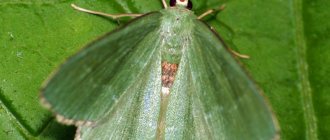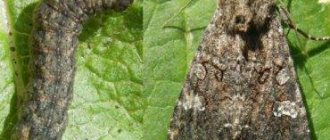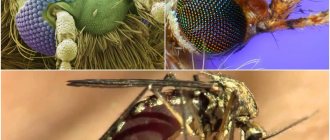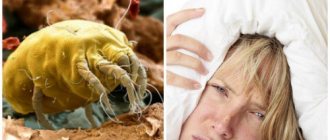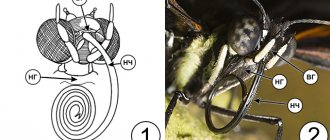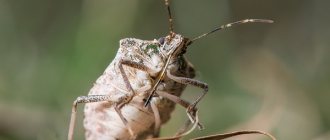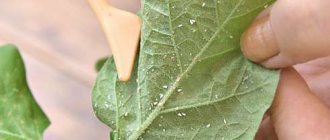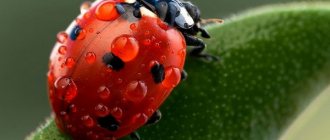What does an insect look like?
Locusts, a group of locusts, are a fairly large pest, 3 cm long and resembling a grasshopper.
Its elongated body is covered on the sides by hard elytra, often colored to match the area in which the insect lives. The color of individuals can be brown, yellowish or green .
The female has an ovipositor in the form of a pointed spike at the end of her body.
Interesting ! The color of locusts is camouflage. It is different even among closely related insects and depends not only on the type of pest, but also on the palette of the environment, the nature of nutrition, and humidity.
In the Asian locust, for example, even the gregarious and solitary forms have different appearances.
Description of locusts
Many have heard about how huge hordes of locusts literally destroyed the entire crop in the fields in a matter of minutes. What does this pest look like?
The body length of this voracious insect can range from 4.5 to 19.5 cm, its hind limbs are bent at the “knees”, and these limbs are much larger than the middle or forelimbs.
A pair of hard elytra cover half-transparent wings, almost invisible when folded. Sometimes the wings can be covered with patterns.
The antennae of this insect are short, much smaller than others. The head is larger than that of other individuals of this family, the eyes are larger than average.
Male locusts make specific sounds, how do they do it? It turns out that there are serrations on the thighs of the locust's hind limbs, and thickenings on the elytra. These parts rub against each other, resulting in a chirping sound that can vary in sound.
The body color of pests does not depend on their genes, but solely on the environment in which the locust lives. And even one offspring that grew up in different regions may have different body colors. Also, the color of the body can be determined by the shape of its development.
Young males and females can be bright emerald, yellow, gray or brown, which allows the pests to camouflage themselves among the surrounding vegetation. They also have pronounced differences by gender.
When individuals enter the gregarious phase of their development, their colors are already the same for all insects, and it is also impossible to distinguish them by gender. A flock of these insects moves briskly: these pests cover up to 100-115 km per day.
Photo
For a visual assessment of what locusts look like, photo below:
The benefits and harms of locusts
The greatest damage is caused by swarms of locusts that destroy fields and plantings. However, the average person, who does not care about the safety of the crop, is more interested in the answer to the question of whether locusts bite. The insect eats exclusively plant food and does not bite humans, unlike its fellow grasshopper.
An equally pressing question is whether locusts are eaten. Orthoptera are the most commonly consumed insects after ants. In African countries they fry it and mix it into flat cakes. Arab women several centuries ago could prepare 2 dozen dishes from locusts. Culinary recipes have lost their relevance due to a shortage of ingredients.
In California, during locust outbreaks, entire feasts were held. The captured insects were soaked in a marinade, then crushed and prepared into soups. The Japanese marinate it in soy sauce and fry it. In a word, there are many recipes for cooking locusts, but not everyone can appreciate its taste, not so much because of inaccessibility, but because of disgust.
Locust and grasshopper: differences
Let's find out the difference between a locust and a grasshopper:
- The grasshopper's whiskers are longer than those of the locust and rise strongly above the head;
- Nature has awarded the grasshopper with longer limbs and massive hind legs - it is better adapted for jumping.
Despite their external similarity, these two insects belong to different orders - grasshoppers and locusts. The former are representatives of the long-whiskered suborder; the locust belongs to the short-whiskered suborder.
There are also differences in the lifestyle of the grasshopper and the locust:
- short mustaches are herbivores , and representatives of grasshoppers are predators;
- locusts are diurnal , raiding crops in broad daylight; long-legged jumpers are considered nocturnal insects;
- grasshoppers lay eggs on the ground parts of plants , and locust pests lay eggs in the soil.
Types of insects
There are a huge number of varieties of locusts. It is impossible to list them all. Some of them include:
Types of locusts
- Moroccan (Dociostaurus maroccanus). Size up to 2 centimeters. Color – reddish-brown with small dark spots. It has a fancy pattern on the back in the form of a light cross. The small size of locusts does not protect crops from total destruction when a whole swarm swoops in. The damage to the land is colossal. For living, locusts have chosen Africa, Central Asia, Egypt, Libya, Algeria, and Morocco. Can be found in European countries.
- Desert. (Schistocerca gregaria). Locusts are distinguished by their large size. The length of the dirty yellow body of the locust can reach 8 cm. The brown wings have a large number of veins. They live in tropical and subtropical countries.
- Migratory. (Locusta migratoria). It is also called Asian. The body has a length of 3.5 to 6 cm. The color is green, brown, gray and yellow. The colorless wings have a smoky tint. Black veins are visible on them. The locusts chose Asian, European, and African countries to live in. This species can be found in southern and Siberian Russian cities, in the Caucasus, and Kazakhstan.
- Italian. (Calliptamus italicus). The peculiarity of the locust is its small body size, its wings are powerful and well developed. Color shades – red, brick, brown, brown, faint pink tones. Longitudinal light stripes and spots are visible on the wings. Habitat: Asia, Mediterranean.
Types of locusts - Egyptian. (Anacridium aegyptium). The female locust is distinguished by its large size. In males they are almost 1.5-2 times smaller. This species chose European countries as its place of residence. Color shades are discreet: gray, light brown, greenish-olive. A characteristic feature of the Egyptian locust is the presence of white and black stripes on the eyes. Representatives of this species are often found in the East, Europe, and northern Africa.
- Rainbow. (Phymateus saxosus). Very poisonous, brightly colored locusts live in Madagascar. The length of its beautiful body, iridescent with all the colors of the rainbow, is about 7 cm. It chooses the leaves of various trees as a shelter, including milkweed, the juice of which is poisonous.
- Siberian. (Gomphocerus sibiricus). A distinctive feature is the small size of the body (up to 2.5 cm). Color brown-brown, olive, gray-green. Widely settled in the regions of the Caucasus Mountains and settlements of Central Asia. Can be found in China, Kazakhstan. It causes significant damage to grain and hay meadows.
- Blue-winged. (Oedipoda caerulescens). The locust is very beautiful, its body size is small (up to 3 cm). The graceful wings are distinguished by a beautiful rich blue color, but at the base it becomes much paler, almost completely losing its color. Their surface is decorated with a beautiful pattern consisting of thin black stripes. The locust settled in the steppes and forest-steppes of European and Asian settlements; it can be found in the Caucasus, western Siberia, and Chinese lands.
Interesting!
There can be about a billion individuals in a swarm of locusts, and the area occupied by it is more than 1 thousand sq.m. The creaking sounds produced by the friction of the wings are similar to thunder.
What plants does it affect?
The pest is unpretentious in food , it eats the ground parts of vegetable plants, cereals, melons, attacks orchards, berry fields, wild trees, not disdaining reed plants.
Leaves, stems, shoots, even the bark of young trees serve as food .
You can learn more about the taste preferences of the merciless insect in the section devoted to its nutrition.
Interesting ! The older an insect gets, the more varied the food it eats becomes. Seasoned individuals are practically omnivorous.
Habitats and food
Various species of this pest can be found in almost any region of the globe (except the South Pole). Some species live in thickets of grass next to any bodies of water.
Others prefer desert or semi-desert climatic zones; they live in rocky areas where shrubs or grass grow.
What do locusts eat and how much can they eat? While the insect lives alone, its appetite is small. If an individual lives in one place, then it eats no more than 200-250 g of food of plant origin in its entire life.
But the locusts' appetite increases significantly the moment these pests flock together. The flock, flying along green spaces, eats everything in its path. After its invasion, bare earth remains without signs of any vegetation. Moreover, the flock usually stops for food in the morning and evening hours.
A swarm of these pests has no preferences in food - they destroy with the same appetite both thickets of reeds and reeds, as well as fruit trees and vineyards.
They also destroy plantings of any grain crops. During long flights, these insects can destroy weaker relatives, making up for the lack of food and water.
Kinds
There are several types of locusts, which differ in appearance and size. The name of the giant locust itself suggests that these insects have a record large size - up to 20 cm . The pest lives in the hot climate of South America.
In Russia, green locusts are found everywhere, resembling a grasshopper - an assistant to farmers and gardeners.
The inconspicuous omnivorous Moroccan pest is very dangerous due to its ability to quickly adapt to insecticides and cause great economic damage.
Capable of migrating in search of a climate suitable for reproduction, the desert locust is known for the fact that the amount of greenery consumed by an individual is equal to its weight .
Nutrition
The locust insect feeds on a variety of greens, including cereals. She eats as much food per day as she weighs. The offspring of one female locust eats an amount of grass equal in weight to the food of two sheep. Everything that comes across the path of a hungry flock - meadows, fields, vegetable gardens, forests - is destroyed in a matter of hours. Sometimes orchards and vineyards are attacked. Berry pickers eat locusts completely, including bark and fruit. When there is a shortage of food, thatched roofs and weaker members of the flock are used as food.
Locust feeding
Reproduction
Mating of pests in a favorable climate can occur from 5 to 12 times a year .
After mating and fertilization, the female lays eggs in the soil , from which larvae will be born after 2 weeks - smaller copies of adult insects.
In the section on locust reproduction you can see photos of insect eggs and larvae.
How do locusts reproduce?
Females begin laying eggs in late summer, in autumn. To do this, she makes a hole in the soil and lays her eggs in it. A special secretion is released from a special gland, which, like foam, fills all the holes between the eggs and creates a strong, reliable protection. Once hardened, the ovipositor appears in the shape of a long tube called an egg capsule.
One female makes several clutches, after which she dies. In European latitudes, the eggs spend the winter in the ground, and with the arrival of warmer weather, white larvae emerge from them. They are distinguished from their parents by their tiny size and underdeveloped wings. After a few hours, the larva acquires a characteristic color and begins to feed intensively. After 4-6 weeks, having undergone 4 molts, it turns into an adult.
In warm tropical climates, females lay eggs year-round and the number of generations per year can be 6-8.
Life phases of locusts
And yet, this insect is unique. Perhaps only it is capable of choosing a form of survival depending on environmental conditions:
- Single form . There is a lot of food, the adult lives separately, feeds on its own, the larvae do not leave the places where they were deposited. A fairly harmless existence that does not cause total damage to forests, fields and vegetable gardens.
- Herd form . This is a problem. This is a catastrophe and a natural disaster. It comes when the locusts' food sources dry up. It begins to change, grow in size, become aggressive and form entire armies. The larvae, which have not yet undergone molting to form wings, walk along the ground in formation, in even rows, like formidable and merciless invaders. Actually, this is so, because after their procession there is no living vegetation left on the surface. The winged fillies begin their destructive years, devouring tens of kilometers of fields, vegetable gardens, and forests. At the same time, laying eggs along the way to raise new future invaders.
Locusts are a global disaster. It is called the “green plague” and there are even special organizations that are constantly working on finding means to combat the pest and leading this very fight. However, many southern states have found their own way to “take revenge” on the harmful insect. It is eaten and even considered a delicacy. And they are bred artificially in special incubator nurseries.
Reproduction mechanism
During the mating season, the male insect begins to secrete a special substance, a hormone, to attract a female. An interested female approaches her partner, who jumps on her astride, as if riding a filly. After this, his genitals are firmly attached to the female’s organs.
The female genitals have an ovipositor equipped with denticles (subsequently, these denticles, like gimlets, dig the ground to bury the egg). The male inserts a spermatophore (a vesicle containing sperm) into this ovipositor. The entire process of depositing sperm into the ovipositor takes 2-14 hours .
After fertilization, the female looks for moist soil, drills holes in it and lays eggs. First, it secretes gluten with a foamy consistency, then eggs. There are from 50 to 70 pieces in one clutch, and the process lasts almost 2 weeks. The emerging larva has difficulty getting out from under the ground. Now 5 molts must pass before the larva transforms into a full-fledged, sexually mature insect.
If there is an abundance of food all year round, then the locusts will also breed all year round. On average, one female manages to lay 6-12 eggs in her entire life. It must be said that locusts do not belong to the category of caring mothers. For example, female bees or wasps supply each cell with a supply of food so that the larva does not starve at first. The locusts have laid their eggs. considers her mission completed and the future fate of her offspring does not interest her. Her motto: “Everyone survives as best they can.”
How does a swarm form?
The swarming phase is present in some species of grasshoppers of the family Acrididae. These insects are usually solitary, but under certain circumstances they become numerous, change behavior and habits, becoming sociable.
There is no taxonomic distinction between locust and grasshopper species. The basis for the determination is whether the species forms swarms under suitable conditions.
These changes are examples of phase polymorphism. Analyzed and described by Boris Uvarov, who played an important role in the creation of the Locust Control Center.
Swarming behavior is a response to overcrowding. Increased tactile stimulation of the hind legs causes an increase in serotonin levels. This causes the insect to change color, eat much more, and reproduce much more easily. The transformation into the swarming form is triggered by multiple contacts per minute over four hours.
A large swarm may consist of billions of individuals scattered over thousands of square kilometers. Consists of 80 million per square kilometer. When insects meet, their nervous systems release serotonin, which causes them to attract each other. This is a necessary condition for swarming.
During outbreaks and the early stages of the rise, only a portion of the population becomes gregarious, with scattered bands over a large area. Over time, the insects become more united, the stripes are concentrated in a smaller area.
During the desert locust plague in Africa, the Middle East, and Asia, which lasted from 1966 to 1969, the number of locusts increased from two to 30 billion in two generations. The covered area has decreased from more than 100,000 square kilometers to 5,000.
Do locusts bite?
Locusts can bite if handled or through prolonged contact, but they have no venom. It does not specifically bite people, like mosquitoes or ticks, because it feeds on plants.
If you do get bitten by a locust, it cannot bite through your skin. The worst thing you'll feel is a prick or like you've been pinched. This is how the insect protects itself.
Moroccan locust
The Moroccan locust, Dociostaurus maroccanus, is found in northern Africa, southern and eastern Europe, and western Asia. In Europe it is found in France, Portugal, Spain, Italy, and the Balkan Peninsula. Lives alone, but after a few years the number increases sharply, becomes sociable, and unites, forming swarms. The species was first described by Thunberg, 1815.
What does it look like
Eggs are laid in pods of 30 eggs. Nymphs resemble wingless adults. They molt five times, each age having larger wing flaps. An adult female locust is 20–38 millimeters long, males are 16–28 millimeters long.
The body color is yellowish-gray with dark spots. There is a cream-colored cross shape on the chest. The elytra are large, transparent, sometimes spotted with brown. The wings are colorless, with veins.
The hind legs are powerful, the femur is black, the lower leg is red. The maturation time from nymph to adult is thirty days.
Behavior
It nests on undisturbed soil and does not breed in arable fields. The optimal amount of precipitation for development is one hundred millimeters. If the spring is unusually hot and there is little rainfall, the number of young insects increases sharply.
Swarms move downhill towards fertile areas, damaging crops. There are several generations in the swarm, the number of adults increases rapidly, reaching 300 per square meter. The winged adults fly at low altitudes, traveling at speeds of eight to ten meters per second.
They migrate sixty kilometers per season. The number decreases in June, when the vegetation disappears.
Borderline species
- The Senegalese grasshopper, Oedaleus senegalensis, exhibits locust-like behavior in the Sahel region;
- Sudan plague, Aiolopus simulatrix - behaves like the locust of eastern Sudan;
- Highland grasshopper, Dissosteira longipennis - exhibits similar behavior to the 1930s epidemic;
- Pale-winged grasshopper, Trimerotropis pallidipennis - occasionally exhibits swarming behavior in western North America, most recently in Nevada, 2021.
